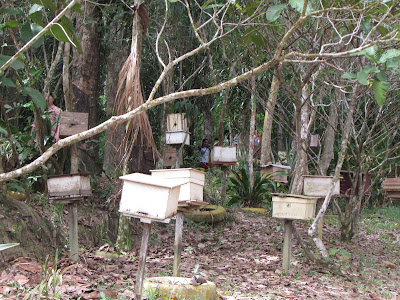Log on to my website www.travelleisureborneo.com or contact me at donaldpeterborneo@gmail.com
Sunday, 26 June 2016
TIP OF BORNEO: The Bee Farm
The Gombizau Bee Farm fascinate me. The farm is located at Matunggong, a sub-district and 43 kilometer from Kudat. Visitors had the opportunity to see how a community of locals managed their bee farm. They used to allow visitors to taste raw honeys straight from the honeycombs but nowadays they won't allow that. They told me, it will disturb the bee's production cycle thus causing it to collapse or swarming (bees leaving their hives). If we have opportunity to taste the honey from the hive, it would have been a wonderful experience because of it's freshness.
The farm reared the Asiatic honeybee call Apis cerana. These bees from a distant look exactly like a common housefly. It is found all over Asia including some parts of the Pacific islands. It seems docile, and if disturbed, it does give a mild sting. But no matter how mild the sting are, it will become painful if they attack in huge numbers. The farm here also harvest the honey from wild giant honey bees call Apis dorsata. These bees, also found all over Asia, are aggressive and cannot be tamed. It live in forest canopies deep inside the jungle. The farmers here told me the bees have ample flowers from the acacia magnum, rubber, coconut, palm oil and mangrove trees to feed on. But the rate of trees been chopped off going around this place, I am not sure what will the bees feed on in future.
Bees are insect related to the wasps and ants. They do have a very important role in our ecological system because they pollinate plants which are essential to human survival. The nectar and pollen they feed on are rich in energy and protein. That is why honey is an important food source. Many believe it contains healing properties. Collecting honey from the wild started 15,000 years ago, while domestication of bees began in Egypt 4500 years ago.
The world is also facing a big problem about the Colony Collapse Disorder (CCD). The problem is this; foraging bees cannot get back to their hive because of navigational failure. Thus the colony disappeared leaving only the queen and a few nurse bees to look after the hive. The worst affected area is Europe. In some part of China, fruit farmers now have to use paintbrush to pollinate the flowers of the fruit trees because of the disappearance of bees. Scientists around the globe are concerned that the CCD will caused food supply to be reduced all over the world. Many theories are forwarded what causes the CCD, but none is conclusive. Among them are Varroa (bee mites), pesticides, lost of habitats and global warming.
At Gombizau, I asked the farmers, did they ever experienced CCD. Not knowing what I meant, I explained to them the meaning. They told me that they experienced sudden reduction in bee colonies in 2011, but nowadays, it seems the bees are back in numbers. That was why they forbade consuming honey from the honeycomb. It was a good experience coming here. Since we cannot taste the fresh honey, buying the bottled one will do.
Subscribe to:
Post Comments (Atom)




No comments:
Post a Comment